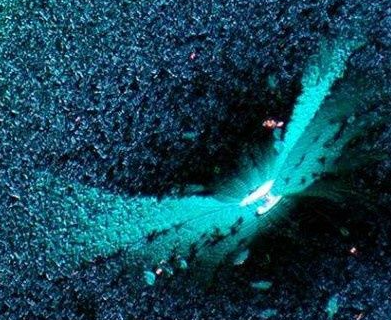Week 8 - Nanotech and Art - Flora Huo
Nanotechnology is a highly interdisciplinary comprehensive discipline, which includes the following four main aspects: nanomaterials, nanodynamics, nanobiology and nanopharmaceuticals, and nanoelectronics. Nanomaterials not only refer to the size of nanometers but also require the materials to have special properties. In the range of 0.1-100 nanometers, the properties of nanomaterials will undergo a sudden change, showing special properties that are different from the original atoms and molecules. Nano dynamic is mainly micromachines and microTVs, which are used in micro-sensors and actuators with transmission machinery, optical fiber communication systems, special electronic equipment, medical and diagnostic instruments, etc.
However, it also could be connected with art. The image looks like a window with smudged glass, but it's actually a magnetic domain of a thin film of iron on top of the crystal. The crystals here are made of magnesium and gallium arsenate.
Graduate student Michael Segnatowitz first deposited some potassium niobium oxide on the surface of silicon, then took this image with an optical microscope, which looked like a distant galaxy.
This photo of the aggregate, which appears to be a cross-section of a tumor or brain, was by Muruganathan Ramanathan, a researcher at the Center for Nanoscale Materials Research at Argonne National Laboratory in Illinois. The postdoctoral scholar took ultrathin pictures of beautiful aggregates of matter, decorating them with patterns using a reactive iron oxide etching process while using heat and solvents to make them more transparent. As a result, it looks more like a modern work of art, seemingly out of touch with advanced scientific research.
References
Chris Robinson; The Role of Images and Art in Nanotechnology. Leonardo 2012; 45 (5): 455–460. doi: https://doi.org/10.1162/LEON_a_00443
Gregor Cevc, Ulrich Vierl, Nanotechnology and the transdermal route: A state of the art review and critical appraisal, Journal of Controlled Release, Volume 141, Issue 3,2010, Pages 277-299, ISSN 0168-3659,https://doi.org/10.1016/j.jconrel.2009.10.016.
J. Am. Chem. Soc. 2014, 136, 32, 11198–11211Publication Date: July 16, 2014, https://doi.org/10.1021/ja505101a
J. Chem. Educ. 2010, 87, 10, 1031–1038 Publication Date: September 14, 2010 https://doi.org/10.1021/ed1000922
Orfescu, C. (2012). NanoArt: Nanotechnology and Art. In A. Ursyn (Eds.), Biologically-Inspired Computing for the Arts: Scientific Data through Graphics (pp. 125-137). IGI Global. https://doi.org/10.4018/978-1-4666-0942-6.ch008




Hi Flora! I very much enjoyed reading your blog this week, and I also learned more about nanotechnology from you in addition to what I learned in lecture. I appreciated your inclusion of a variety of examples in which nanotechnology and art intersect. Is nanotechnology something that interests you? Also, as I read your post I wonder if you understand how the laws of physics change when on the nanoscale (this was something that particularly shocked and confused me). Great post, and thank you for helping me learn more!
ReplyDelete